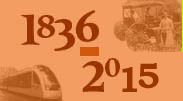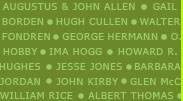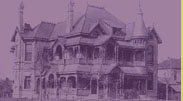LANDMARKS - Old Houston
Market Square
Market Square is bounded by Travis, Milam, Congress and Preston streets, was originally designed as the commercial hub of the city. It has remained a geographic centerpiece of downtown Houston since the arrival of the city's founders, John Kirby and Augustus Chapman Allen, in 1836.
The square was donated to the city in 1854 by Augustus Allen and was used as an open air produce market. Very near Allen's Landing, the original port of Houston, the downtown business district grew around the square. Early city landmarks included the briefly used Texas Capitol and White House. In addition, several City Halls rose and fell at Market Square, each destroyed by fire.
The historic square, which has recently been re-landscaped, is surrounded by 19th century architecture, housing a variety of businesses, entertainment venues, nightclubs and dining establishments. Market Square is located directly between Allen's Landing and the Theatre District.
Capital Building - Capital Hotel - Rice Hotel
For two years, in 1837-1839, Houston was the capital of the republic of Texas. The capital building located at what is now 917 Texas Avenue, was a two-story, simple, unadorned, frontier-style frame structure. After the government was moved to Austin, the capital was remodeled and became the Capital Hotel. Here, in 1858, Anson Jones, the last president of the Republic of Texas, committed suicide. J. L. Barnes acquired the Capital Hotel in the 1870's demolished it in 1882 and replaced it with a new Capital Hotel, designed by A. Groesbeck. William M. Rice bought the hotel in 1885 and renamed it the Rice Hotel. In 1912, Jesse Jones erected the present building of the Rice Hotel, now listed on the National Register for Historic Places.
The Scanlan Building, at 405 Main Street, occupies the site of what used to be the Executive Mansion. It was a private one-and-a-half story home with dormer windows, built by Francis R. Lubbock in 1837. That same year the Republic of Texas bought the house for use as the Executive Mansion. Two presidents, Sam Houston and Mirabeau Lamar, lived there during their terms of office.
Kennedy Trading Post
The Kennedy Trading Post, also known as the Kennedy Bakery after the bakery business that the family maintained on the premises for a long time, is located there. Listed on the National Register for Historic Places the Kennedy Trading Post was built in 1847 by Nathaniel Kellum, one of Houston's early developers. The building is believed to be the oldest public two-story frame building in the city and now houses a bar named La Carafe. At the bar entrance an historical marker proclaims that Sam Houston once slept there.
The older buildings in the downtown area, dating from the late 1800's to the 1900's, are monuments to diverse activity of early Houstonians. These buildings housed hotels, railroad stations, banks, retail outlets, manufacturing and (at the turn of the century) oil, gas and related industries.
Union Station
In March of 1880, former President Ulysses Grant came to Houston aboard the first train to arrive at the new Union Station on Crawford Avenue; Geronimo, Chief of the Apaches, in 1894 passed through this station on a Federal train as a prisoner. The original Union Station was replaced later by one designed and built by Warren and Wetmore, the architects who designed New York's Grand Central Station.
Sheppard Building
The Sheppard Building, at 219 Main Street, built in 1883, is an imposing Victorian structure, named for B.A. Sheppard who, along with T. W. House, introduced banking to Houston in the 1850's. The old Troy Laundry Building, at 910 Prairie, dates from 1882 and features Romanesque arches under an embellished metal cornice.
Cotton Exchange Building
Cotton played a major role in the economy of nineteenth and early twentieth century Houston and the center of the trade was the old Cotton Exchange Building was completed in 1884. This Renaissance Revival style building was made of red Philadelphia pressed brick faced with Texas limestone. The building was originally topped by a bale of cotton, made of zinc; this was later removed. Currently it is used as an office building.
Sweeney, Coombs and Frederick Building
The Sweeney, Coombs and Frederick Building, on Main and Congress, was built in 1899. The building originally housed a jeweler's shop and has been restored by Harris County and entered on the National Register for Historic Places.
By the turn of the century, the two-and three-story structures in the downtown area were giving way to taller buildings. Among the tallest structures dating from this period were the 11-story Scanlan Building; the Texas Company's Building, a 13-story structure at 1111 Rusk, and the 13-story Union National Bank Building.
A series of comprehensive sketches of the city's representative business enterprises dating back to the 1890s is highlighted in the Industrial Advantages of Houston, Texas.






